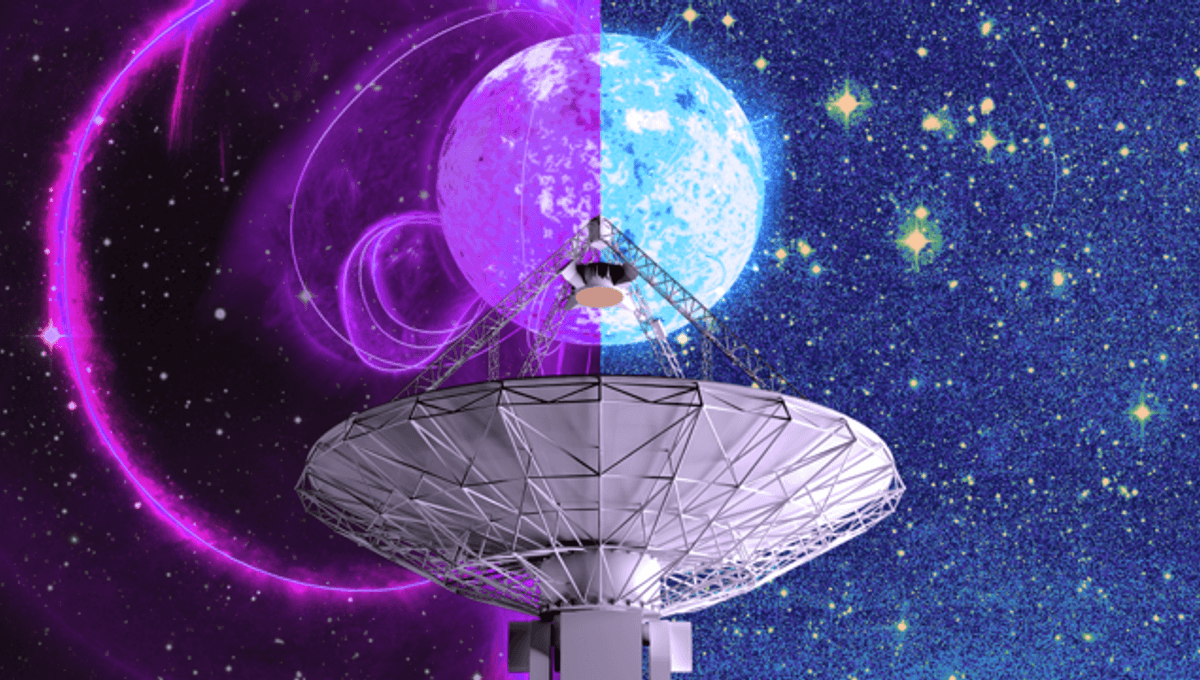
Radio waves have been detected from what appears to be a pulsar, with just one problem – it‘s spinning thousands of times more slowly than most such objects, and hundreds of times slower than theory says is possible. Several similar signals have been found recently, but this is the most extreme yet, and also presents a rare case where explanations offered for some others can be ruled out. As some astronomers race to develop a model, others are seeking more examples of this strangeness.
Pulsars are rapidly spinning neutron stars, which, like all neutron stars, are thought to have formed from the collapse of supernovae not large enough to form black holes, leaving a staggeringly dense body behind. Energy left over from the explosion causes them to spin very rapidly driving the creation of radio waves, often compared to the sweeping beam of a lighthouse. As pulsars age, they slow down, and their radio signals get weaker and eventually stop.
There is an inverse relationship between the time between each radio beam of a pulsar and its strength. Consequently, we don’t find any pulsars with cycles longer than two minutes, since the signals are too weak to detect.
Or at least that was the case until a new class of radio telescopes started noticing objects collectively known as long-period radio transients. These signals share at least some characteristics with the signal from a pulsar but are far too slow for their brightness.
The newly announced discovery, ASKAP J183950.5−075635.0 – or ASKAP J1839-0756 to its friends – is the most extreme example yet, with 6.45 hours between each main pulse.
Halfway between ASKAP J1839-0756’s main pulses, weaker ones, known as interpulses, have been observed. This is a rare phenomenon among pulsars, occurring in only about 3 percent of cases, but a well-understood one.
University of Sydney PhD student Yu Wing Joshua Lee, who led the discovery, explained to IFLScience that it occurs when the magnetic and rotational axis of the neutron star are highly misaligned. “If the Earth’s magnetic poles were close to the equator,” Lee said, “and the Earth was producing radio signals like a pulsar, suitably placed observers would see signals of unequal strength.”
The detection of the secondary pulse is one of the features that makes Lee and co-authors suspect this is a type of pulsar, albeit a very strange one. More specifically, they think the source is a magnetar, a type of exceptionally magnetized neutron star.
However, Lee admitted to IFLScience that only the haziest model has been proposed of how a magnetar could produce signals on this timescale, since they also usually have gaps lasting just seconds. “It’s not well understood,” Lee said. “We can’t really speculate or explain.” The only known magnetar with a similar period emits in X-rays, none of which have been found for ASKAP J1839-0756.
The alternative to a magnetar, the researchers argue, is an entirely new class of object, unlike anything we have seen before, whose physics we can barely guess.
In the three years since the first long-period radio transient was found, astronomers have discovered enough examples to know these are more than an aberration. Last year, a team of astronomers found that one example, GLEAM-X J0704−37, is the product of a red dwarf and a white dwarf in a mutual orbit lasting 2.9 hours. The result is a radio beam that sweeps the skies on the same timeline, looking at first sight like the product of a pulsar.
That discovery left open the question of whether all long-period radio transients come from such couples. ASKAP J1839-0756 indicates they do not.
Other long-period radio transients have been found in crowded parts of the sky, making spotting their source in optical wavelengths almost impossible. Like GLEAM-X J0704−37, ASKAP J1839-0756’s location is uncluttered enough to make searching easier, but in this case, no red dwarf was found.
Given the apparent location of the beam – 13,000 light years away – all but the smallest red dwarfs should be detectable at that distance, given the power of the instruments used. The field strength required to make ASKAP J1839-0756’s signal is at least a hundred times stronger than that detected from any white dwarf on its own, so the range of possible explanations becomes quite narrow.
Similarly, other theories that may explain some long-period radio transients appear a poor fit for this one. The members of the new category with the shortest periods might conceivably represent ordinary pulsars where some exceptional factor allows them to keep producing a signal while remaining to spin unusually slow. While this can be contemplated for examples with 18-minute periods, it’s hard to see how it could apply to something 15 times slower.
Meanwhile, the broad spectrum of the signal rules out aliens to everyone other than those who always think it’s aliens.
Lee told IFLScience that the team continues to monitor the pulses, which haven’t stopped. Aside from that, he said that they’ve “done everything that is possible at the moment” to search for the source at other wavelengths. He has no expectation that time on larger telescopes would resolve the question.
The study is published in Nature Astronomy.
Source Link: Suspected Pulsar Is Spinning Hundreds Of Times More Slowly Than Ought To Be Possible